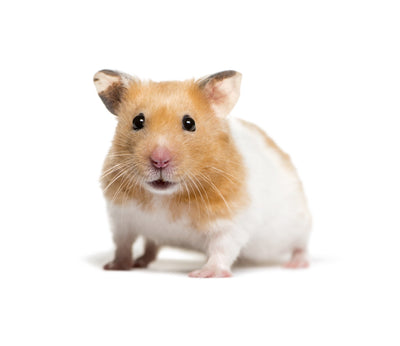
Hamsters
Syrian hamsters are most commonly kept as a pet. They can be trained and are fun to watch and play with, but should never be kept with other hamsters, as they are very territorial. Hamsters are mostly nocturnal creatures so their playtime may not fit well with a young child's schedule, making them a more suitable pet for older children.
Hamsters engage in an elaborate, and often adorable, cleaning ritual, washing their faces and cleaning out their ears with their feet!
Never use a habitat that has a wire bottom, which is not good for their tender feet. Make sure it has plenty of floor space and climbing parts as well as escape proof! They also like plenty of toys to keep busy and an exercise wheel (solid, not wire) or ball.
Minimum size for their habitat should be 450 square inches, recommended 650 square inches of continuous space for them to run around with no levels or connecting tubes.
Hamsters love to burrow and hideout. Provide plenty of comfy carefresh natural paper bedding for them to tunnel and a special place for sleeping, 6 inches of bedding is optimal.
How to Clean a Hamster’s Home (we recommend a thorough clean about once a week)
Hamsters need clean habitats to keep them from getting sick. Follow these steps for cleaning your hamster’s home:
- Spot clean daily.
- Once a week, move your hamster to a safe area: an exercise ball would be an ideal spot to keep your hamster while cleaning it’s cage as long as you can keep on eye on him. A second habitat or deep container that your hamster can’t get out of will also work.
Larger habitats may only need to be totally cleaned out every 3 or 4 weeks or even longer, if you have a very large habitat with lots of bedding or a particular clean hamster. Some experts recommend using the one-third technique where the bottom one-third is old bedding, and new bedding is put on top. Leaving some old bedding makes it less stressful when you put them back in their cleaned habitat.
- Dispose of old bedding: don’t worry about cleaning your hamster’s bedding, just throw it away responsibly (it can be composted) and start fresh. Hamsters can sometimes hoard their food, so tossing the bedding every time you clean will help prevent it from molding.
- Wash the habitat: only use a mild soap and warm water to thoroughly rinse and clean your hamster’s home, water dispenser, toys and food dish. Make sure everything is thoroughly cleaned off and dried before adding new carefresh bedding and returning your hamster back to its fresh, clean home.
Hamsters love to eat! Because hamsters are omnivores, a natural food made to mimic the seeds and grains they would eat in the wild is best, along with daily fresh water. Never feed your hamster chocolate or sweets.
Once a week give them a small amount of boiled egg or meal worms that are rich in protein. A small cube of fruit or vegetable (cauliflower, broccoli, pear, peach, banana) two or three times a week is plenty.




